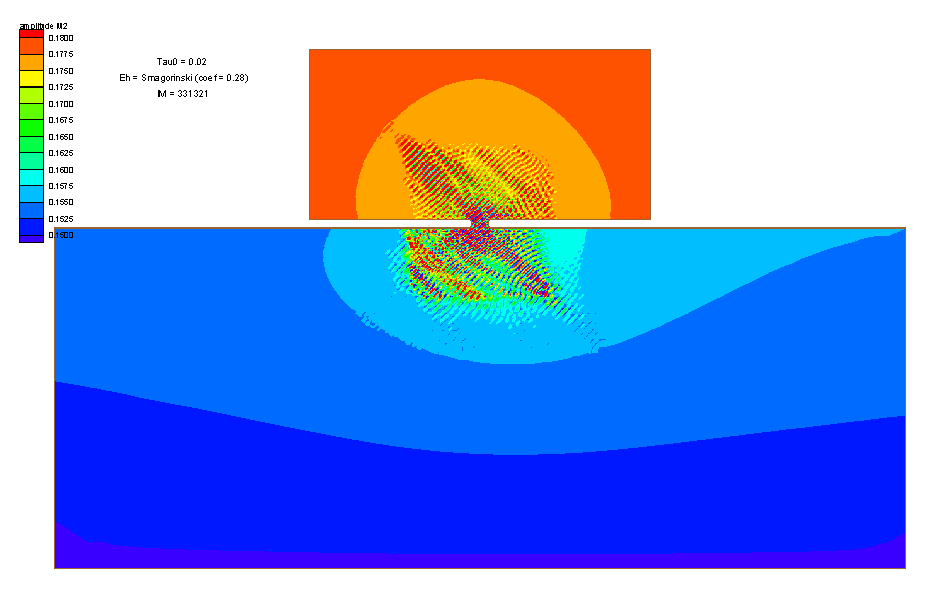- Community
- Documentation
- User’s Manuals, Compile Options, FAQs, Wiki
- Example Problems
- Reports and Publications
- Related software
- News
- 2020 Users Group Meeting Presentations
- 2019 ADCIRC Users Group Meeting
- 2019 Texas ADCIRC Week
- 2018 ADCIRC Week
- 2017 ADCIRC User Group Meeting and ADCIRC Boot Camp
- 2016 ADCIRC User’s Group Meeting and ADCIRC Boot Camp
- 2015 ADCIRC User’s Group Meeting and ADCIRC Boot Camp
- 2014 ADCIRC Workshop and Bootcamp
- ADCIRC Workshop 2013 Final Agenda
- 2011 ADCIRC Workshop Press Release
- 2010 ADCIRC Workshop Abstracts
- 2008 ADCIRC Workshop
- Hurricane Storm Surge Forecasts
- Example Hurricane Katrina Simulation
- Products
- ASGS
ADCIRC
The Official ADCIRC Web Site
Home » » Documentation » Example Problems » Idealized Inlet Test Cases » Idealized Inlet Test Cases Results
Idealized Inlet Test Cases Results
Information on the meanings of the IM values is found here.
The Zipped Archive contains the input and output files for each test case.
|
Version of ADCIRC Code |
TAU0 |
Eh |
IM |
Zipped Archive |
Graphics |
|
44_15 |
0.02 |
2 |
121221 |
|
|
|
44_15 |
0.02 |
2 |
131321 |
|
|
|
44_15 |
0.02 |
2 |
111111 |
|
|
|
44_15 |
0.02 |
2 |
111121 |
|
|
|
44_15 |
0.02 |
2 |
0 |
|
|
|
44_15 |
0.02 |
4 |
121221 |
||
|
44_15 |
0.02 |
4 |
131321 |
||
|
44_15 |
0.02 |
4 |
111111 |
||
|
44_15 |
0.02 |
4 |
111121 |
||
|
44_15 |
0.02 |
4 |
0 |
||
|
44_15 |
0.02 |
6 |
121221 |
||
|
44_15 |
0.02 |
6 |
131321 |
||
|
44_15 |
0.02 |
6 |
111111 |
||
|
44_15 |
0.02 |
6 |
111121 |
||
|
44_15 |
0.02 |
6 |
0 |
||
|
Bug Note: There was a bug found in the code (version 44.15) for any runs where the first digit of IM was 2 or 3. This bug was corrected in version 44.17. |
|||||
|
44_17 |
0.02 |
6 |
321221 |
||
|
44_17 |
0.02 |
6 |
331321 |
||
|
44_17 |
0.02 |
6 |
331321 |
||
|
44_17 |
0.02 |
6 |
331321 |
||
|
44_17 |
0.02 |
6 |
131321 |
||
|
44_17 |
0.02 |
6 |
311121 |
||
|
44_17 |
0.02 |
6 |
311121 |
||
|
44_17 |
0.02 |
6 |
311121 |
||
|
45_06 |
|
|
|
|
|
|
45_06 |
|
|
|
|
|
|
45_06 |
|
|
|
|
|
|
45_08 |
|
|
|
|
|
|
45_08 |
|
|
|
|
|
|
45_08 |
|
|
|
|
|
|
45_08 |
|
|
|
|
|
|
50_99 |
|
|
|
|
|
|
50_99 |
|
|
|
|
|
Information about the naming convention of test cases:
Legacy. Several improvements have been made in recent versions of ADCIRC, including computation in double precision, the changeover to an improved algorithm for the integration of area around a node, and a recommended higher tolerance for iteration convergence. The result of these improvements is that output from v45.06 is not the same as (is better than) output from earlier versions using the same input data. In order to confirm that the differences are due to improvements and not bugs, v45.06 was recompiled to use single precision and the old area integration algorithm. The input files for the test cases were run just as they were for previous versions, including their old convergence tolerances—usually 1e-5. The resulting output data were labeled “legacy” and are for comparison with old versions of ADCIRC.
Forward. In order to compare the results from v45.06 with future versions of ADCIRC, the convergence tolerance was changed from 1e-5 to 1e-10 in the fort.15 files. The code was then run with no changes, i.e., in the default, as-distributed condition. The results were labeled “forward” on the results pages; these new input files will be used for current and future testing of ADCIRC.
Parallel. ADCIRC v45.06 was run in parallel on 2 CPUs to confirm that it gave the same results as in a serial run. The results were labeled “parallel” on the results pages.
Serial. This is a single processor run of an example problem; it is the same as the “forward” test of v45.06.
PC. The predictor-corrector time stepping algorithm was activated by selecting a negative time step. This test was added to the suite after I inadvertently introduced a bug into the predictor-corrector algorithm while fixing a different bug. Please note that the predictor-corrector algorithm has not been applied as broadly as ADCIRC’s default time stepping procedure. Note also that the predictor-corrector algorithm passed on four example problems (i.e., produced results very similar to “serial” test),
but failed (blew up) on the Shinnecock Inlet problem.
Hot. This test was carried out by cold starting the example problem and running it until a hot start file was generated, approximately halfway through. Then it was hot started and run to completion. The results were compared to the “serial” case, where the simulations start from cold and run all the way to completion. The purpose was to ensure that a hotstart does not change or perturb the solution. I discovered and fixed two hotstart bugs with this test case, one in 2D for input files where NOLIFA = 0, and another one in 3D.
Jason G. Fleming, December 2005



































